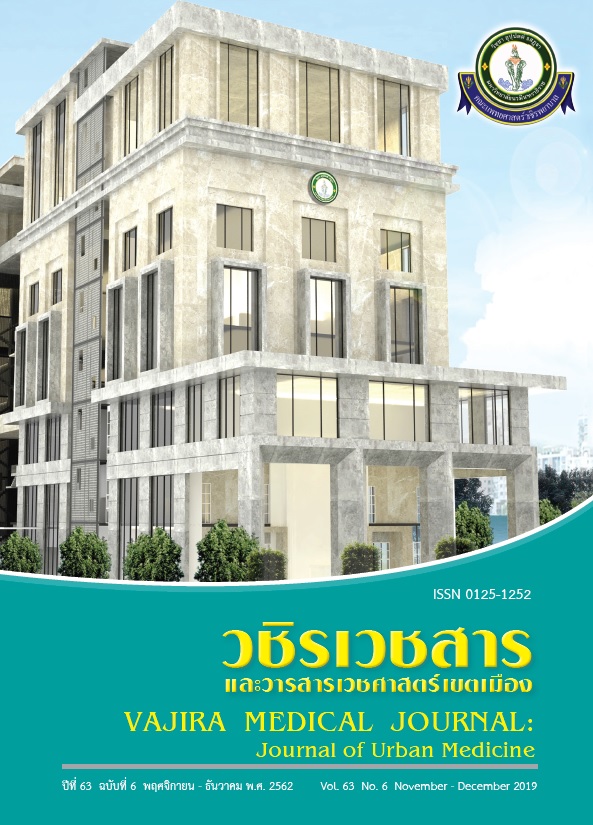Growth and Developmental Outcomes of Very Low Birth Weight Infants in First Two Years of Life
Main Article Content
Abstract
Objective: To determine growth and developmental outcomes of very low birth weight infant in the first two years of life
Methods: The study population comprised of very low birth weight infants (<1500 g), born in Faculty of Medicine Vajira Hospital Navamindrahiraj University from January 1, 2013 to December 31, 2015. We collected medical record data from birth to age two years to find the growth and development outcome.
Results: Ninety three very low birth weight infants were enrolled. Average gestational age at birth was 29 weeks and average birth weight was 1,110 grams. Sepsis was the most complication at 87.1%. At two year of life, the prevalence of delay development was 16.1%. The weight, length and head circumference below the third percentile were 36%, 20.8% and 15% respectively.
Conclusion: The very low birth weight infants who were born in Faculty of Medicine Vajira hospital, Nawamintharathirat University had a great number of prevalence of delay growth and development outcome at 2 years of age. It might be because the normal infants lost follow up. However it is the opportunity for improvement in the process of post discharge follow up and promote health in this infant group.
Downloads
Article Details
References
Horbar JD, Carpenter JH, Badger GJ, Kenny MJ, Soll RF, Morrow KA, et al. Mortality and neonatal morbidity among infants 501 to 1500 grams from 2000 to 2009. Pediatrics 2012;129:1019-26.
Cejas G, Gómez Y, Roca Mdel C, Domínguez F. Neurodevelopment of very low birth weight infants in the first two years of life in a Havana tertiary care hospital. MEDICC Rev. 2015 Jan;17(1):14- 7.
Kusuda S, Fujimura M, Uchiyama A, Totsu S, Matsunami K; Neonatal Research Network, Japan. Trends in morbidity and mortality among very-low-birth-weight infants from 2003 to 2008 in Japan. Pediatr Res 2012;72:531-8.
Hack M, Wilson-Costello D, Friedman H, Taylor G, Schluchter M, Fanaroff AA. Neurodevelopment and predictors of outcomes of children with birth weights of less than 1000g: 1992-1995.Arch Pediatr Adolesc Med. 2000;154:725-31.
Surveillance Developmental and Screening of Infants and Young Children. Pediatrics.2001;108(1):192–5.
Park JS, Han J, Shin JE, Lee SM, Eun HS, Park MS, et al. Post discharge growth assessment in very low birth weight infants. Korean J Pediatr.2017;60:64–69.
Vohr BR, Wright LL, Dusick AM, Mele L, Verter J, Steichen JJ,et al. Neurodevelopmental and functional outcomes of extremely low birth weight infants in the National Institute of Child Health and Human Development Neonatal Research Network, 1993-1994. Pediatrics.2000;105:1216-26.
Hack M, Weissman B, Borawski-Clarke E. Catchup growth during childhood among very lowbirthweight children. ArchPediatr Adolesc Med.1996;150:1122-9.
Geoffrey WF, Doyle LW, Noni MD, Callanan C. Very low birthweight and growth into adolescence. Arch Pediatr Adolesc Med.2000;154:778-84.
Peralta-Carcelen M, Jackson DS, Goran MI, Royal SA, Mayo MS,Nelson KG. Growth of adolescents who were born at extremely low birth weight without major disability. J Pediatr. 2000;136:633-40.
Moore T, Hennessy EM, Myles J, Johnson SJ, Draper ES, et al. (2012) Neurological and developmental outcome in extremely preterm children born in England in 1995 and 2006:The EPICure studies. BMJ 34: 7961.
Sangtawesin V, Singarj Y, Kanjanapattanakul W. Growth and development of very low birth weight infants aged 18-24 months at Queen Sirikit National Institute of Child Health. J Med Assoc Thai. 2011;94:S101-6.
Kanjanabut S. Preterm infant. In: Noipayak P, Amornchaicharoensuk Y, Tantracheewathorn T, Sirimongkolchaiyakul O, Phuthongkam W, editors. Pediatics in Metropolis. 1st ed. Bangkok:Text&Journal publication; 2016. p.1-21
Hack M. Follow-up for high-risk neonates. In:Fanaroff AA, Martin RJ, editors. Neonatal-Perinatal Medicine. 6th ed. St. Louis: Mosby;1997. p. 952-7
Fenton TR, Kim JH. A systematic review and meta-analysis to revise the Fenton growth chart for preterm infants. BMC Pediatr. 2013;13:59.
WHO Multicentre Growth Reference Study Group. WHO Child Growth Standards: Length/height-for-age, weight-for-age, weight-for-length, weight-for-height and body mass index-for-age:Methods and development. Geneva: World Health Organization, 2006


